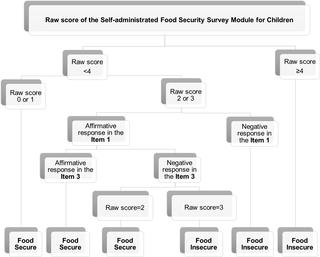Our official English website, www.x-mol.net, welcomes your feedback! (Note: you will need to create a separate account there.)
Application of the mixture item response theory model to the Self-Administered Food Security Survey Module for Children.
PLOS ONE ( IF 3.7 ) Pub Date : 2020-01-23 , DOI: 10.1371/journal.pone.0228099 Isabel Maia 1 , Milton Severo 1, 2 , Ana Cristina Santos 1, 2
PLOS ONE ( IF 3.7 ) Pub Date : 2020-01-23 , DOI: 10.1371/journal.pone.0228099 Isabel Maia 1 , Milton Severo 1, 2 , Ana Cristina Santos 1, 2
Affiliation

|
BACKGROUND
The Self-Administered Food Security Survey Module for Children was developed to assess food insecurity of individual children and has not been used in Portugal. We aimed to apply the mixture item response theory model to the Self-Administered Food Security Survey Module for Children, to assess its reliability and validity, and to estimate the cut-offs of the food security status for Portuguese children.
METHODS
The scale was self-administered to 2132 children of the Generation XXI birth cohort. The internal consistency was assessed using Cronbach's alpha. We evaluated dimensionality and/or clustering, and Latent Class Analysis, Latent Trait Analysis and Mixture Latent Trait Analysis were tested. The number of classes and/or traits were defined according to the Akaike Information Criterion, Bayesian Information Criterion, Adjusted Bayesian Information Criterion, Vuong-Lo-Mendell-Rubin Likelihood Ratio Test, Bootstrapped Likelihood Ratio Test and Entropy. Construct validity was explored using socio-demographic characteristics. The classification tree was used to define cut-offs to predict cluster membership.
RESULTS
The best model was a Mixture Latent Trait Analysis with 1 factor and 2 classes (food security and food insecurity), assuming class variant item parameters (for items 1 and 3). Based on the estimated posterior probabilities, the food insecurity prevalence was 17.6%. Cronbach's alpha was 0.617. A higher proportion of less-educated mothers and low-income households was observed in the food insecurity class. The classification tree showed an accuracy of 100.0% by identifying the food security and food insecurity groups.
CONCLUSION
Our results supported that the Self-Administered Food Security Survey Module for Children provides a valid and reliable measure, which allows the identification of food insecurity among Portuguese children.
中文翻译:

混合项目反应理论模型在儿童自助食品安全调查模块中的应用。
背景技术针对儿童的自我管理的粮食安全调查模块是为评估个别儿童的粮食不安全而开发的,在葡萄牙尚未使用。我们旨在将混合项目响应理论模型应用于儿童自我管理的粮食安全调查模块,以评估其可靠性和有效性,并估计葡萄牙儿童粮食安全状况的临界值。方法该量表由XXI世代出生的2132名儿童自行管理。使用Cronbach的alpha评估内部一致性。我们评估了维数和/或聚类,并测试了潜在类别分析,潜在特征分析和混合物潜在特征分析。类别和/或特征的数量是根据Akaike信息标准,贝叶斯信息标准,调整贝叶斯信息准则,Vuong-Lo-Mendell-Rubin似然比检验,自举似然比检验和熵。利用社会人口学特征探讨了结构效度。分类树用于定义临界值,以预测群集成员。结果最好的模型是具有1个因素和2类(粮食安全和粮食不安全)的混合潜在性状分析,假设类别变量项目参数(针对项目1和3)。根据估计的后验概率,粮食不安全患病率为17.6%。克朗巴赫的alpha为0.617。在粮食不安全人群中,受教育程度较低的母亲和低收入家庭比例更高。通过识别粮食安全和粮食不安全群体,分类树显示了100.0%的准确性。
更新日期:2020-01-24
中文翻译:

混合项目反应理论模型在儿童自助食品安全调查模块中的应用。
背景技术针对儿童的自我管理的粮食安全调查模块是为评估个别儿童的粮食不安全而开发的,在葡萄牙尚未使用。我们旨在将混合项目响应理论模型应用于儿童自我管理的粮食安全调查模块,以评估其可靠性和有效性,并估计葡萄牙儿童粮食安全状况的临界值。方法该量表由XXI世代出生的2132名儿童自行管理。使用Cronbach的alpha评估内部一致性。我们评估了维数和/或聚类,并测试了潜在类别分析,潜在特征分析和混合物潜在特征分析。类别和/或特征的数量是根据Akaike信息标准,贝叶斯信息标准,调整贝叶斯信息准则,Vuong-Lo-Mendell-Rubin似然比检验,自举似然比检验和熵。利用社会人口学特征探讨了结构效度。分类树用于定义临界值,以预测群集成员。结果最好的模型是具有1个因素和2类(粮食安全和粮食不安全)的混合潜在性状分析,假设类别变量项目参数(针对项目1和3)。根据估计的后验概率,粮食不安全患病率为17.6%。克朗巴赫的alpha为0.617。在粮食不安全人群中,受教育程度较低的母亲和低收入家庭比例更高。通过识别粮食安全和粮食不安全群体,分类树显示了100.0%的准确性。



























 京公网安备 11010802027423号
京公网安备 11010802027423号